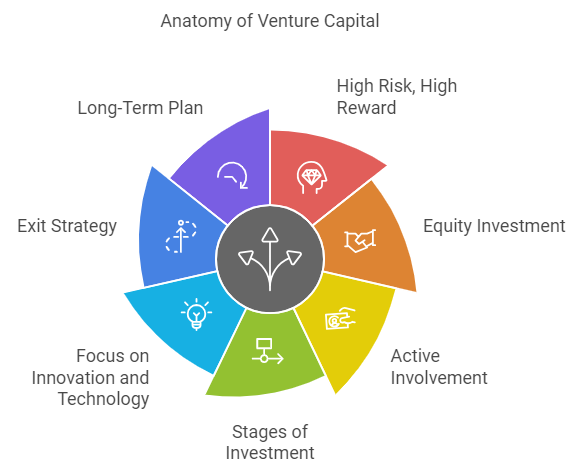Starting a business can be an exhilarating experience, but securing the necessary funding can be a daunting task. So, whether you're launching a startup or expanding an existing small business, access to capital is crucial to not only start your entrepreneurial adventure but also to take it to new heights.
Traditional loans often come with strict requirements and lengthy approval processes, making them less accessible to new and small business owners. Fortunately, there are numerous easy business loans and financing options tailored to meet the unique needs of small businesses and startups.
These modern solutions, such as venture capital funding, crowdfunding, numerous small business loans, etc., offer flexibility, speed, and accessibility, ensuring that your entrepreneurial dreams can become a reality without unnecessary financial headaches.
Hence, to help you make the right choice, in this guide, we will dive deeper and explore all the easy business capital loans options available that can help your business thrive in the Philippines.

What Does Self-Funding Mean For Your Business? It's Importance And Potential Drawbacks

Self-funding, often referred to as bootstrapping, means using your own financial resources to start and grow your business in the Philippines. This could involve you dipping into your personal savings, using your credit cards, or reinvesting your profits from the business.
One of the primary advantages of self-funding is maintaining full control over your business decisions without external interference. You won’t need to answer to investors or lenders, allowing you to steer your business according to your vision and values.
Moreover, self-funding can lead to a more disciplined financial approach, as every Philippine peso spent is carefully considered.
Advantages of Self-Funding Your Business
1. Complete Control
When you self-fund your business, you maintain full control over all decisions. There's no need to answer to investors or lenders, allowing you to steer the business according to your vision and values. This independence can be particularly beneficial in ensuring that the company stays true to its original mission and goals.
2. Flexibility and Speed
Self-funding allows for quicker decision-making and implementation. Without the need to seek approval from external parties, you can move swiftly, take advantage of new business opportunities, adapt to market changes, and pivot strategies as needed. This agility can be a significant competitive advantage.
3. Financial Discipline
Using personal funds often instills a strong sense of financial discipline. Entrepreneurs tend to be more cautious and prudent with their expenditures when their own money is at stake. This careful management can lead to more efficient operations and better financial health for the business.
4. Ownership and Profits
By self-funding, you retain full ownership of the business. This means that all profits generated by the business are yours to reinvest or distribute as you see fit. There's no obligation to share profits with investors or pay interest to lenders, maximizing the financial benefits for you as the owner.
5. Lower Debt Risk
Self-funding reduces the need to take on debt, thereby lowering your financial risk. Without the burden of loan repayments or interest, your business can operate with greater financial stability. This can be particularly important during the early stages of a business when cash flow is usually a little tight.
6. Enhanced Credibility
Self-funding demonstrates a strong commitment to your business, which can enhance your credibility with customers, partners, and future investors. It shows that you believe in your business enough to invest your own money, which can be a powerful statement of confidence and dedication.
Drawbacks of Self-Funding Your Business
1. Limited Financial Resources
One of the primary disadvantages is the limitation on available funds. Your savings or resources may not be sufficient to cover all the necessary expenses for starting and scaling your business.
This financial constraint can hinder growth and restrict your ability to seize opportunities that require substantial capital.
2. Personal Financial Risk
Using your own money to fund your business can put your finances at considerable risk. If the business fails, you stand to lose not only your investment but also potentially impact your financial stability, savings, and credit score. This can have long-term consequences on your financial health.
3. Slow Growth Potential
Without external funding, your business may grow more slowly. This lack of sufficient capital can limit your ability to invest in marketing, research and development, hiring skilled employees, and other critical areas that drive business expansion, like competing with well-funded competitors.
4. Strain on Personal Relationships
Self-funding can put a strain on personal relationships, especially if you rely on family or friends for financial support. The pressure of financial risk and the potential for business-related conflicts can affect your personal life and relationships.
5. Missing Out on Other Business Opportunities
By investing your own money into the business, you might miss out on other investment opportunities that could provide a safer or higher return. The opportunity cost of self-funding can be significant if the business does not perform as expected.
Also Read: 6 Things You Need for Small Business Loan Requirements
What is Venture Capital, And What Are its Key Characteristics
Venture capital is a form of private equity financing provided by investors to startups and small businesses with high growth potential. These investors, known as venture capitalists, offer capital in exchange for equity, or partial ownership, of the company.
Venture capital is typically used to scale businesses rapidly, allowing them to reach significant milestones and market positions.

Top Characteristics of Venture Capital
1. High Risk, High Reward
Venture capital investments are inherently risky, as they are made in early-stage companies that may not yet have a proven track record. However, the potential for high returns is significantly high if the company succeeds and grows rapidly.
2. Equity Investment
Venture capitalists invest in exchange for equity, meaning they acquire a stake in the company. This can range from a minority share to a significant controlling interest, depending on the amount invested and the company's overall valuation.
3. Active Involvement
Venture capitalists often take an active role in the companies they invest in. This can include providing strategic guidance, helping with key business decisions, and leveraging their networks to facilitate growth. They may also take seats on the company's board of directors if needed.
4. Stages of Investment
Venture capital is typically deployed in stages aligned with the company's development phases. These stages include seed funding, early-stage funding, and later-stage funding. Each stage is designed to meet specific growth needs, from product development to market expansion.
5. Focus on Innovation and Technology
Venture capital tends to be concentrated in high-growth industries such as technology, biotechnology, and clean energy. These sectors offer significant potential for innovation and disruption, aligning with the high-risk, high-reward nature of VC.
6. Exit Strategy
Venture capitalists seek to realize their returns through a successful exit strategy. Common exit strategies include initial public offerings (IPOs), mergers, and acquisitions. The goal is to sell their equity stake at a significantly higher value than the initial investment.
7. Long-Term Plan
Venture capital investments typically have a long-term plan, often ranging from 5 to 10 years. This allows time for the company to develop, scale, and achieve significant milestones before the venture capitalists seek to exit.
How To Get Venture Capital Funding in The Philippines?
Securing venture capital in the Philippines requires a strong business plan, a scalable and high-growth potential business model, and a dedicated team.
Here's a brief overview of the steps involved in the process -
- Develop a Compelling Business Plan: This should clearly outline your business model, market opportunity, financial projections, and exit strategy.
- Build a Strong Team: Investors look for passionate and experienced founders. A solid team increases your chances of success.
- Network Actively: Attend industry events, connect with investors, and leverage your network to build relationships.
- Create a Powerful Pitch Deck: A concise and visually appealing presentation is crucial for capturing investor attention.
- Showcase Traction: Demonstrate early market traction, customer acquisition, and revenue generation.
- Understand Investor Expectations: Venture capitalists typically invest in high-growth businesses with the potential for substantial returns.
- Consider Accelerators and Incubators: These programs can provide mentorship, resources, and potential investor connections.
Also Read: Explained: Typical Terms of Small Business Loans
What is Crowdfunding, And What Can a Business Expect From it?

Crowdfunding is a method of raising capital through the collective effort of a large number of individuals, typically via online platforms.
Instead of seeking substantial sums from a few investors or financial institutions, businesses accept small contributions from a vast audience, usually in exchange for rewards, equity, or simply to support a cause.
Top Characteristics of Crowdfunding
1. Collective Funding
Crowdfunding is essentially the pooling of small amounts of money from a large number of people to finance a project or venture. It’s a democratic approach to funding, where anyone can contribute.
2. Diverse Investor Base
Crowdfunding platforms attract a wide range of investors, from individuals to institutions. This diversity of investors can provide valuable insights and support.
3. Reward-Based or Equity-Based
Crowdfunding platforms typically offer two main models: reward-based, where backers receive tangible rewards, and equity-based, where backers become shareholders in the company.
4. Leverage of Social Networks
Crowdfunding heavily relies on social media and networks to reach a wide audience and generate support for a project. Successful campaigns often involve strong community engagement.
5. Risk and Reward Sharing
Crowdfunding allows for risk-sharing as multiple people contribute small amounts. While there’s a risk of not reaching the funding goal, successful projects can yield high rewards for backers.
Advantages of Crowdfunding in The Philippines
1. Access to a Wide Investor Base
Crowdfunding platforms provide access to a vast pool of potential investors, allowing businesses to reach a broader audience than traditional financing methods, which subsequently increases the chances of securing funding.
2. Market Validation
A successful crowdfunding campaign can serve as a powerful market validation tool. It demonstrates customer interest and demand for a product or service, which can be invaluable for attracting additional investors or securing traditional financing.
3. Customer Acquisition and Retention
Crowdfunding can be a highly effective marketing tool. By engaging with backers and offering rewards, businesses can build a loyal customer base from the outset.
4. Faster Funding
Compared to traditional financing methods, crowdfunding can be a much faster way to raise capital. This allows businesses to accelerate product development, market-entry, and growth.
5. Community Building
Crowdfunding fosters a sense of community among backers and the business. This can lead to strong customer loyalty and advocacy, which can be beneficial for long-term growth.
6. Reduced Financial Pressure
Spreading the financial risk across multiple investors can allow entrepreneurs to alleviate the pressure of providing funding for their businesses all by themselves to meet stringent financial performance benchmarks often associated with traditional investors.
Disadvantages of Crowdfunding in The Philippines
1. All-or-Nothing Funding Model
Many crowdfunding platforms operate on an all-or-nothing basis, meaning the project only receives funds if the entire funding goal is met. If the target isn't reached, the project receives nothing, leaving the campaign a failure and the project without funding.
2. Dilution of Ownership
In equity-based crowdfunding, raising funds often involves giving up ownership equity in the company. This can lead to a dilution of ownership for existing shareholders, including the founders, and can potentially affect control over the business.
3. Regulatory Challenges
Crowdfunding is a relatively new industry, and regulations vary widely across different jurisdictions. Navigating the legal and compliance landscape can be complex and time-consuming for both the platform and the campaign creators.
4. Public Scrutiny
Crowdfunding exposes a project to public scrutiny. Negative comments, criticisms, or even outright attacks can harm a project's reputation and deter potential backers. Managing public perception can be challenging.
5. Time-Consuming
Running a successful crowdfunding campaign requires significant time and effort. Creating compelling content, engaging with backers, and managing the campaign can be demanding, diverting attention from core business operations.
Also Read: Types of Business Loans in the Philippines
Apply for N90's fast financing solutions and watch your business soar. Quick online applications and approvals within 24 hours! Fuel Your Business Success Today!
What Are Small Business Loans And What Are The Different Types Available For Entrepreneurs in The Philippines
A small business loan is a financial product specifically designed to meet the funding needs of SMEs operating in the Philippines.
It provides entrepreneurs and business owners with access to capital to cover various expenses such as operational costs, expansion initiatives, equipment purchases, or inventory restocking.
These loans typically come in different forms, including term loans, lines of credit, and equipment financing, offering varying levels of flexibility and repayment terms.
In simple words, small business loans are crucial for helping businesses start up, grow, and overcome financial challenges, contributing to overall economic development.
Types of Small Business Loans Available In The Philippines
1. Term Loans
Term loans provide a lump sum amount that must be repaid with interest over a fixed period. They are suitable for purchasing equipment, expanding operations, or covering significant business expenses.
2. Lines of Credit
A line of credit offers a revolving credit limit that can be borrowed from as needed. Businesses can access funds when required and pay interest only on the amount used and is ideal for managing cash flow fluctuations.
3. Small Business Administration (SBA) Loans
While not directly available in the Philippines, understanding SBA loans can be helpful for comparison. These government-backed loans offer favorable terms for small businesses in many countries.
4. Government-Backed Loans
The Philippine government, through agencies like the Small Business Corporation (SB Corp) and Land Bank of the Philippines, offers various loan programs with a specific focus on supporting SMEs, often with lower interest rates and flexible terms.
5. Merchant Cash Advances
A merchant cash advance provides a lump sum based on a percentage of future credit card sales. On the other hand, repayment is done through daily withdrawals from credit card sales, often with high fees. It's a quick option but comes with higher costs.
Eligibility Requirements For Applying For a Small Business Loan in The Philippines
- Legal Business Entity: Your business must be legally registered and operating. This includes having the necessary permits and licenses.
- Business Age: Most lenders require a minimum operational period, often ranging from six months to two years.
- Financial Performance of The Business: A consistent profit history and stable financial performance is crucial. Lenders will evaluate your income statements, balance sheets, and cash flow statements.
- Business Plan: A well-structured business plan outlining your goals, strategies, and financial projections is often required.
- Collateral Requirements: Some lenders may require collateral, such as property or equipment, to secure the loan.
- Citizenship: You must be a Filipino citizen.
- Age Requirements: Most lenders have age restrictions, typically between 21 and 65 years old.
- Credit Score: A good personal credit score can positively impact your loan application.
- Minimum Income: Some lenders might require proof of personal income, especially for sole proprietorships.
Advantages of Small Business Loans in The Philippines
1. Access to Capital
Small business loans provide much-needed capital to fund operations, expansion, or equipment purchases. This can be crucial for businesses that lack sufficient internal resources.
2. Business Growth
With additional capital, businesses can invest in marketing, research and development, or new product lines, leading to increased revenue and market share.
3. Job Creation
Small business loans can support job creation by allowing businesses to hire more employees, contributing to economic growth.
4. Improved Cash Flow
Loans can help businesses manage cash flow fluctuations, ensuring timely payments for suppliers, employees, and other expenses.
5. Competitive Advantage
Access to capital can help small businesses compete more effectively with larger rivals by investing in technology, infrastructure, and marketing.
Disadvantages of Small Business Loans in The Philippines
1. High-Interest Rates
Small business loans often come with higher interest rates compared to traditional consumer loans. This can significantly increase the overall cost of borrowing and reduce profit margins.
2. Collateral Requirements
Many lenders require collateral to secure a business loan. This means putting your assets at risk, which can be a major drawback for businesses with limited assets.
3. Lengthy Application Process
Obtaining a small business loan can be time-consuming due to the extensive documentation and financial analysis required by lenders. This delay can hinder business growth and expansion plans.
4. Limited Loan Amounts
Small business loans often have lower loan limits compared to larger businesses. This can restrict the ability to fund significant expansion projects or capital-intensive investments.
5. Potential for Debt Burden
Taking on a business loan increases the company's debt burden. If the business faces financial challenges, meeting loan repayments can become difficult, potentially leading to financial distress.
Also Read: Common Types of Bank Loans in the Philippines
Top Alternative Financing Options Available in The Philippines

Traditional bank loans often present hurdles for SMEs due to strict requirements and lengthy approval processes. Fortunately, a range of alternative financing options has emerged to cater to the diverse needs of businesses.
These alternatives provide more flexible and accessible funding solutions, empowering entrepreneurs to pursue their growth aspirations.
Here, take a look at some of the top alternative financing options available in the Philippines while also shedding some light on their key features and suitability for different business stages -
1. Crowdfunding
Crowdfunding involves raising funds from a large number of people through online platforms. It can be reward-based, where backers receive products or services in return, or equity-based, where backers become shareholders.
In essence, crowdfunding offers the opportunity for businesses to build a customer base and generate a little buzz while securing financing.
2. Peer-to-Peer Lending
This platform connects borrowers and lenders directly, bypassing traditional financial institutions. It often offers more flexible terms and quicker approval processes compared to banks. However, interest rates can be higher.
3. Invoice Factoring
Invoice factoring involves selling unpaid invoices to a third party at a discount to receive immediate cash. This can improve cash flow but comes with fees and the loss of control over customer relationships.
4. Microfinance Institutions
These institutions provide small loans to individuals and businesses with limited access to traditional financing. They often focus on underserved communities and offer flexible repayment terms.
5. Angel Investors
Angel investors are high-net-worth individuals who invest in early-stage companies in exchange for equity. They provide not only capital but also mentorship and industry expertise.
6. Venture Capital
Venture capitalists invest in high-growth potential startups in exchange for equity. They typically provide larger amounts of funding compared to angel investors and have a more active role in the company's management.
Also Read: Benefits and Disadvantages of Small Business Loans
How To Effectively Apply For a Business Loan in The Philippines - Top Points to Remember
Applying for and securing a business loan in the Philippines requires organised preparation and a strategic approach, as this increases your chances of approval and obtaining optimal terms.
So, in this section, we will outline the crucial steps that you must comply with to effectively apply for and secure a business loan in the Philippines. Carefully understand these key considerations and assemble the necessary documentation accordingly, as by doing so, you will significantly enhance your chances of having a successful loan application process.
Here, take a look at some of the top points to remember to apply for a business loan in the Philippines effectively -
1. Comprehensive Business Plan
A well-structured business plan is essential. It outlines your business's goals, strategies, financial projections, and how the loan will contribute to growth. A strong business plan demonstrates your understanding of the market and your ability to manage the business effectively.
2. Solid Financial Performance
Lenders prioritize businesses with a history of profitability. Accurate and up-to-date financial statements, including income statements, balance sheets, and cash flow statements, are crucial, as these documents showcase your business's financial health and ability to manage finances responsibly.
3. Excellent Credit History
A strong credit score, both personal and business, significantly improves your chances of loan approval and securing favorable terms. Building and maintaining good credit is vital for accessing affordable financing.
4. Clear Loan Purpose
Clearly explain how the loan will be used to benefit your business. Clearly outlining your specific needs and how the funds will contribute to growth demonstrates your financial acumen and responsible borrowing.
5. Collaterals and Guarantees
Prepare necessary documents related to collateral if required. Understanding the collateral requirements and being prepared to provide them can accelerate the loan process. Additionally, be prepared to offer personal guarantees if needed.
6. Accurate and Complete Documentation
Gather all required documents, including business permits, licenses, tax returns, and identification cards. Ensure accuracy and completeness to avoid delays and potential rejections.
7. Realistic Loan Amount
Request a loan amount that aligns with your business needs and repayment capacity. Overborrowing can strain your finances and negatively impact your business.
8. Repayment Plan
Demonstrate a clear understanding of how you will repay the loan. A well-structured repayment plan showcases your financial responsibility and ability to manage debt.
9. Compare With Other Providers
Compare offers from different lenders to find the best terms and interest rates. Don't settle for the first offer you receive.
10. Build Relationships
Networking with lenders can help you establish a rapport and increase your chances of approval. Building strong relationships can be beneficial in the long term.
Also Read: Understanding and Solving Common Cash Flow Problems
How To Find The Best Business Loan in The Philippines - Key Points To Consider
Securing the right business loan is pivotal for a company's growth and stability in the Philippines. However, with various loan options available, making an informed decision can be quite a challenge.
So, in this section of the article, we will take a look at some of the crucial factors to consider when searching for the best business loan in the Philippines. By carefully evaluating these key points, entrepreneurs can increase their chances of finding the most suitable financing solution that suits their needs perfectly.
Here, check out the top points to consider when applying for a business loan in the Philippines to help you select the best one -
1. Assess Your Business Needs
Clearly define the purpose of the loan. Are you seeking working capital, funding for expansion, or purchasing equipment? Understanding your specific requirements will help narrow down your options.
2. Compare Interest Rates and Fees
Interest rates and associated fees can significantly impact the overall cost of the loan. Compare offers from different lenders to find the most competitive rates. Consider factors like fixed or variable interest rates and hidden charges.
3. Evaluate Repayment Terms
Analyze the loan term and repayment schedule. Choose a loan that aligns with your business's cash flow and ability to repay. Consider factors like amortization period, grace periods, and prepayment penalties.
4. Understand Collateral Requirements
Some loans require collateral, which is an asset that the lender can seize if you default. Evaluate if you are comfortable pledging collateral and the potential impact on your business.
5. Consider Lender Reputation and Customer Service
Research the lender's reputation, financial stability, and customer reviews. Look for lenders with a track record of supporting small businesses and providing excellent customer service.
6. Explore Alternative Financing Options
Don't limit yourself to traditional bank loans. Consider options like crowdfunding, peer-to-peer lending, or invoice factoring. These alternatives may offer more flexibility and faster approval processes.
7. Read the Fine Print
Thoroughly review the loan agreement, including terms and conditions, interest rates, fees, and repayment schedule. Understand the implications of defaulting on the loan.
Conclusion
As we have seen from this comprehensive article, securing the right type of financing option is pivotal for the success and growth of any small business or startup in the business.
While traditional bank loans remain the primary option among Filipino entrepreneurs, however, the emergence of alternative financing avenues has expanded opportunities for numerous budding entrepreneurs.
Today, business owners looking for more accessible financing options in the Philippines have countless options to choose from. Still, they must consider certain important factors before finalizing their choices, such as loan amount, interest rates, repayment terms, and collateral requirements, etc.
Ultimately, Filipino businesses need to explore a variety of options, compare lenders, and understand the terms and conditions before making a decision.
Why is this necessary? A well-structured financing plan will provide them with the necessary capital to fuel business growth and overcome challenges. In contrast, responsible borrowing and financial management practices will ensure long-term success.
Frequently Asked Questions (FAQs)
1. What are the 3 types of business loans in the Philippines?
Three main types of business loans in the Philippines:
- Term loans: A lump sum repaid with interest over a fixed period.
- Lines of credit: A revolving credit limit for flexible borrowing.
- Merchant cash advances: A lump sum based on future credit card sales.
2. How to finance a business in the Philippines?
Financing a business in the Philippines involves exploring various options. Traditional bank loans, government-backed programs like those offered by the Small Business Corporation, and alternative sources such as crowdfunding, peer-to-peer lending, and angel investors can be considered.
Moreover, factors like business stage, size, and risk tolerance influence the best choice, so it is a good idea to first carefully evaluate the interest rates, repayment terms, and the amount needed before deciding which one is the right one.
3. What are the different types of loans in financial management?
Loans are classified based on various factors, including purpose, security, and repayment terms. Common types include:
- Secured loans: Require collateral like property or assets. Examples: home loans, car loans, loans against property.
- Unsecured loans: Don't require collateral but often have higher interest rates. Examples: personal loans and credit card loans.
- Short-term loans: Smaller amounts with shorter repayment periods, often used for immediate needs.
- Long-term loans: Larger amounts with longer repayment terms, typically for assets like homes or businesses.
4. What are the 3 classifications of businesses in the Philippines?
The three primary classifications of businesses in the Philippines are:
- Sole Proprietorship: Owned and managed by a single individual, with unlimited personal liability for business debts.
- Partnership: Owned by two or more individuals, sharing profits and liabilities. It can be a general partnership or a limited partnership.
- Corporation: A separate legal entity owned by shareholders, with limited liability for its owners.













